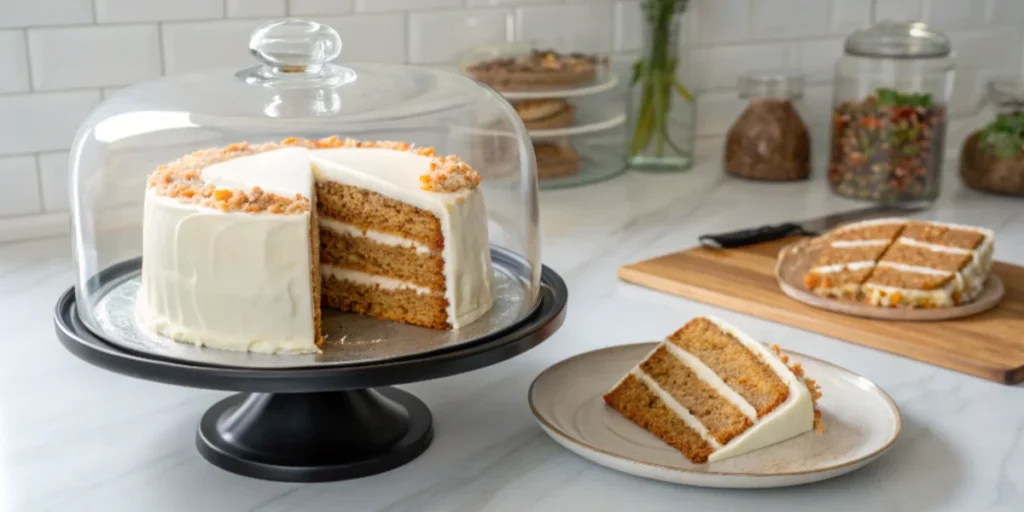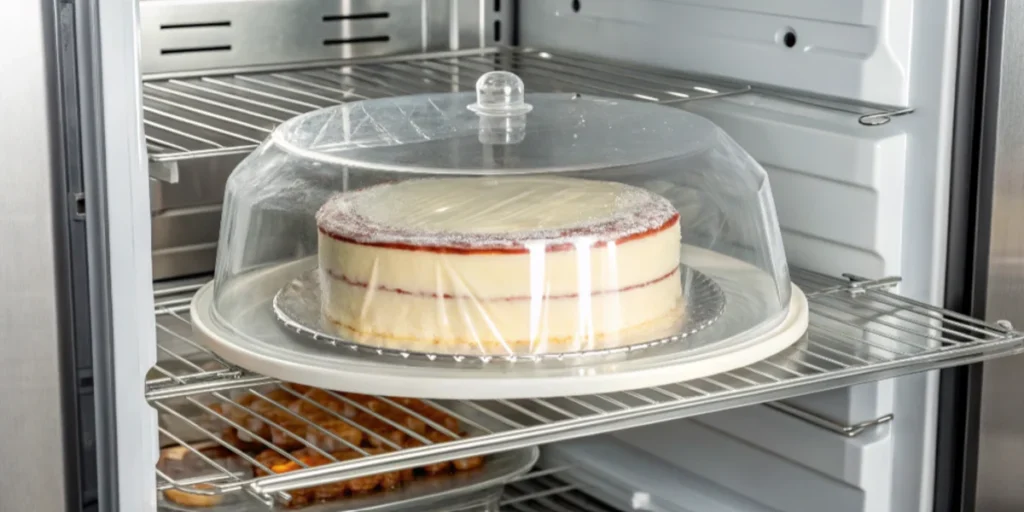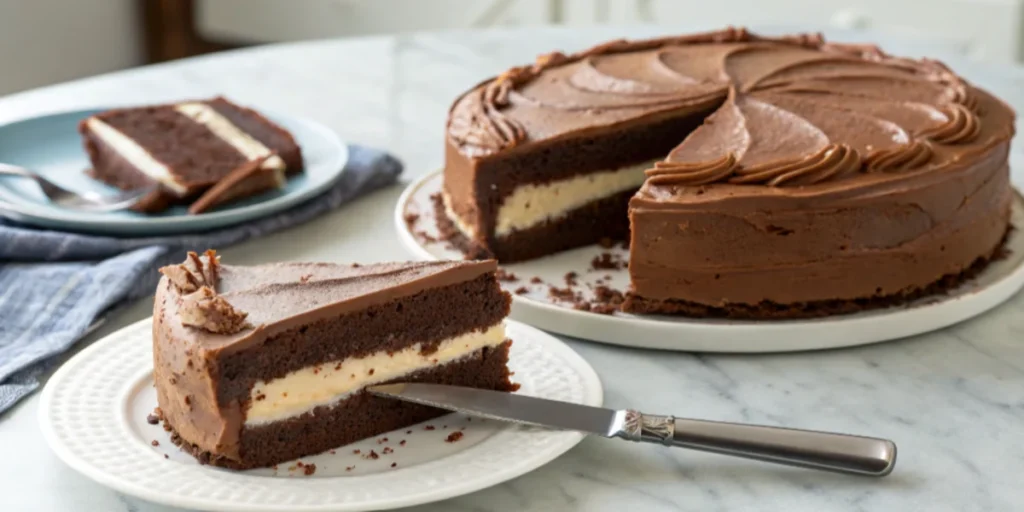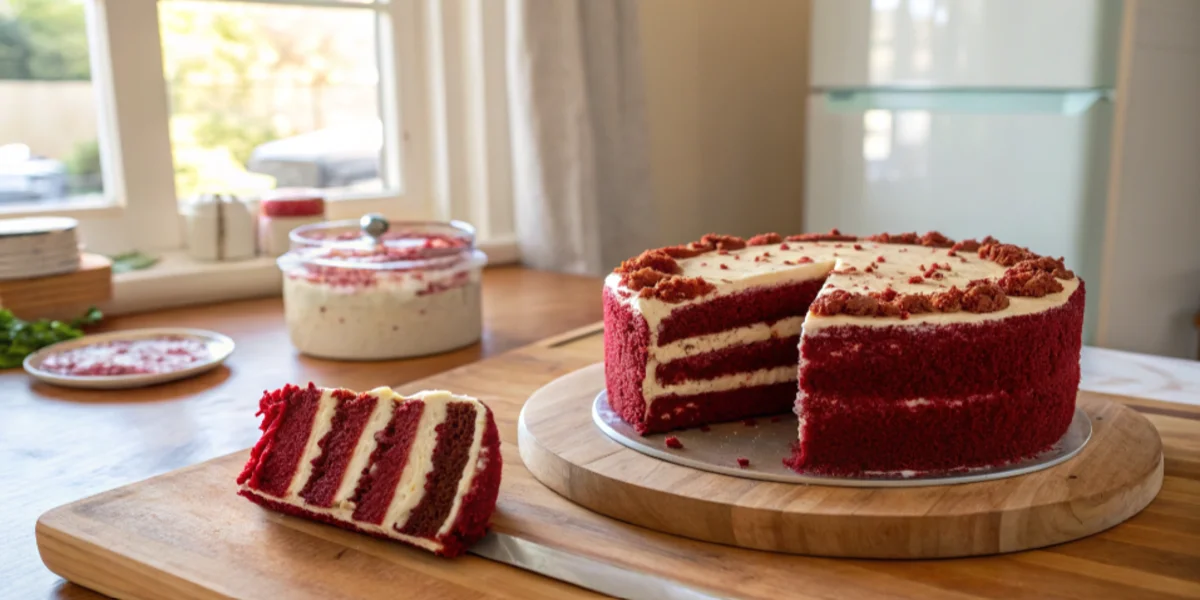Introduction: Why This Question Matters—The Scoop on Cream Cheese Cake Safety
Alright, let’s be real—cream cheese cake refrigeration is a big deal. Cake is a party favorite, right? Whether it’s a birthday, wedding, or random Tuesday (because cake makes everything better), you can’t go wrong with a rich, creamy filling. But when cream cheese enters the mix? Oh, now we’re talking decadence! That tangy-sweet combo? Game-changer.
But here’s the thing—cream cheese is, well, dairy, and dairy can be tricky. You’ve probably wondered, Does cream cheese cake refrigeration really matter? Or can it just sit out on the counter and still be safe to eat? Don’t worry—you’re not the only one asking. So let’s settle this once and for all with some simple, no-fuss tips on keeping your cream cheese-filled cakes safe and oh-so-tasty.
Table of contents
Understanding Cream Cheese: Why Refrigeration Matters
First, let’s break down why cream cheese cake refrigeration is so important (don’t worry, no tests later!). Cream cheese is a soft cheese made from milk and cream, and like most dairy products, it’s highly perishable. Why? It has a high moisture content, making it the perfect environment for bacteria to thrive if left at room temperature too long. Yikes, right?
The FDA strongly recommends refrigerating cream cheese products at or below 40°F to keep them safe. This rule applies to anything that includes cream cheese—like your fabulous cake filling.
Here’s the deal: cream cheese-based fillings absolutely need to stay below 40°F. The “danger zone” for food safety starts at 40°F and stretches to 140°F, and once your cake hits that range, bacteria can multiply faster than you can say, “Where’s my fork?” Even if your kitchen feels chilly, ambient temperatures can still be risky. Play it safe and keep your cake cool!
If you’re curious about why cream cheese fillings are so irresistible, check out this comprehensive guide to baking with cottage cheese to discover more creative uses for creamy ingredients.
When Should You Refrigerate Cakes with Cream Cheese Filling?

Oh, you bet the amount of cream cheese matters when it comes to cream cheese cake refrigeration. A light swirl of cream cheese frosting? Maybe it’s fine to leave it out for a little while. But a thick, luscious layer of cream cheese filling? Straight to the fridge, my friend. The more cream cheese packed into your cake, the more crucial it is to keep it chilled.
And let’s not ignore the environment! If it’s the middle of summer and your kitchen feels like a sauna, even a tiny bit of cream cheese can spoil quicker than usual. High humidity doesn’t help either—it can make your cake soggy and accelerate spoilage. Leave a cream cheese-filled cake out too long, and you’ll have a droopy, sad dessert on your hands—not exactly the kind of showstopper you were going for.
For a deeper understanding of keeping fillings fresh and smooth, explore how to firm up cream cheese filling.
Can You Leave Cakes with Cream Cheese Filling Out? (Spoiler: It Depends)
So, can you leave that beautiful cake out on the counter? Well, yes—but only for a short time. The general rule is that cakes with cream cheese filling can stay at room temperature for about 2 hours max. After that, you’re rolling the dice on food safety. And trust me, no cake is worth a tummy ache (or worse).
If you’re hosting a party and worried about keeping the cake cool, consider serving it in smaller portions and refrigerating the rest. Nobody’s going to complain about a fresh slice straight from the fridge, especially if the filling is creamy and rich.
How to Tell If a Cream Cheese Cake Has Gone Bad
This part might make you a little squeamish, but it’s important. If you’re unsure about your cake, here’s what to check for:
- Weird Smell: Fresh cream cheese has a mild, slightly tangy scent. If your cake smells sour or just… funky, it’s time to toss it.
- Texture Changes: Look for separation or slimy spots in the filling—those are clear signs it’s spoiled.
- Mold: Yep, if you see even a tiny speck of mold, the whole cake has to go. Better safe than sorry.
When in doubt, trust your senses. If something feels off, it’s better to play it safe.
Tips for Properly Storing Cakes with Cream Cheese Filling

If you want to keep your cake fresh and fabulous, proper storage is key. Start by wrapping it tightly in plastic wrap or storing it in an airtight container to prevent it from drying out. Refrigerate the cake immediately after serving, especially if you’re dealing with leftovers.
Pro Tip: If you’ve got a fancy cake with lots of decorations, pop it in the fridge uncovered for about 20 minutes to firm up the frosting before wrapping it. This keeps everything intact and Instagram-worthy.
To maintain freshness, start by wrapping your cake tightly in plastic wrap or storing it in an airtight container. For a similar storage guide, read about what to eat with pecan dip, which offers handy storage tips for dips and spreads.
Freezing Cakes with Cream Cheese Filling: Does It Work?
Absolutely! Freezing is a great option if you’ve got extra cake and no plans to eat it right away. Cream cheese fillings freeze surprisingly well, as long as you wrap everything up tightly. Use a double layer of plastic wrap and a layer of aluminum foil to protect it from freezer burn.
When you’re ready to eat, let the cake thaw in the fridge overnight. Don’t try to speed things up by leaving it on the counter—the filling could get watery, and that’s a buzzkill.
Does Refrigeration Affect the Taste or Texture of Your Cake?

Now, let’s address the elephant in the room—does refrigerating a cake ruin the taste or texture? Honestly, it depends on the type of cake. Refrigeration can make sponge cakes feel a little dense or dry, but cream cheese fillings hold up beautifully in the cold. If you’re worried, just let the cake sit at room temperature for about 30 minutes before serving to soften things up.
For best results, keep the cake covered in the fridge. This prevents the fridge’s dry air from messing with the frosting or the cake layers. Oh, and if you’ve got other strongly scented foods in the fridge (hello, leftover garlic bread), use an airtight container to keep those smells from creeping into your cake.
Common Myths About Refrigerating Cakes with Cream Cheese Filling
There’s a lot of chatter out there about how refrigeration ruins cakes. Let’s set the record straight:
- Myth #1: Refrigeration Always Dries Out Cakes
Not true if you store it right. Wrap your cake tightly or keep it in a sealed container, and you’ll lock in the moisture just fine. - Myth #2: All Cream Cheese Fillings Are the Same
Not quite! Some fillings are mixed with stabilizers or sugar, which can extend their shelf life a bit. But the safest bet? Treat all cream cheese fillings like they’re perishable, just to be sure.
Why Cream Cheese Fillings Are So Popular (And Worth the Effort)
Let’s not overlook why cream cheese fillings are so beloved. They add a tangy, slightly savory flavor that perfectly balances the sweetness of cakes. Whether it’s layered between fluffy carrot cake or stuffed inside a rich red velvet roll, cream cheese filling takes desserts to the next level.
Sure, it comes with some storage challenges, but isn’t it worth a little extra effort for that luscious texture? Think of it like the VIP of cake fillings—high maintenance but totally worth it.
What About Cream Cheese Frosting? Does It Need the Same Treatment?
Here’s a fun fact: cream cheese frosting is slightly more forgiving than pure cream cheese filling. Why? The added sugar in frosting acts as a preservative, slowing down bacterial growth a little. That said, it’s still a dairy product, so refrigeration is your safest bet.
If your frosting is thin or mixed with whipped cream, it’s even more perishable. So while you might be able to leave a heavily sugared frosting out for a short while, it’s smarter to store the entire cake in the fridge whenever possible.
Hosting Tips: Keeping Cakes Fresh During a Party
If you’re hosting an event and want to keep your cake fresh without running back and forth to the fridge, try these tricks:
- Serve in Rounds: Slice and serve portions as needed, keeping the rest of the cake in the fridge until it’s time to refill.
- Cooler Bags: If you’re outside or away from home, an insulated cooler bag with ice packs can work wonders.
- Chilled Cake Stand: Some cake stands come with compartments for ice packs underneath. Stylish and practical!
Nobody wants their cake to spoil halfway through the party, and these little hacks can save the day.
How Humidity Impacts Cake Storage
Humidity is often the unsung villain of cake storage. In humid environments, moisture in the air can seep into your cake, causing it to become sticky or soggy. For cakes with cream cheese filling, this added moisture can accelerate spoilage.
To combat this, store your cake in an airtight container or wrap it in plastic wrap before refrigerating. If you’re in a particularly humid area, avoid leaving the cake uncovered on the counter for even short periods. Keeping it cool and sealed is the best way to maintain that perfect texture.
Signs Your Cake Is Past Its Prime (Even If It’s Refrigerated)
Refrigeration slows spoilage but doesn’t stop it entirely. Over time, cakes with cream cheese filling can lose their fresh flavor and texture. Here’s how to spot a cake that’s no longer at its best:
- Dry Layers: The cake itself feels dry, especially around the edges.
- Off Taste: Even if it looks fine, an older cake might taste sour or slightly metallic—definitely not the vibe you want.
- Frosting Separation: If the cream cheese frosting or filling starts to separate into layers, it’s a sign the cake’s been around too long.
When in doubt, remember that most refrigerated cakes are best enjoyed within 2–3 days.
Why Freezing Is a Game-Changer for Leftovers
Here’s the thing: freezing doesn’t just preserve your cake; it actually helps lock in freshness. Cakes with cream cheese filling freeze beautifully because the filling holds its shape and texture well. If you’re baking ahead for a big event, freezing the cake can be a stress-free way to stay prepared.
When freezing, it’s all about the layers. Wrap each piece tightly in plastic wrap, then add a layer of foil or place it in a freezer-safe bag. Label the package with the date (because let’s face it, you won’t remember otherwise!). When thawing, take your time—let the cake sit in the fridge overnight for the best results.
Storing Decorated Cakes Without Ruining the Design
If your cake is a masterpiece of decoration—think fondant flowers, piping, or intricate designs—refrigeration can be tricky. The cool air can cause condensation, which might make your decorations run or lose their shape.
To avoid this, refrigerate the cake uncovered for about 15–20 minutes to let the frosting harden slightly. Once firm, cover it loosely with plastic wrap or store it in a cake box. If your fridge has high humidity, add a silica packet or two nearby to absorb excess moisture (just don’t let it touch the cake!).
Health and Safety: Why It’s Better to Be Safe Than Sorry
Food safety isn’t just about avoiding spoilage—it’s about keeping your loved ones healthy. Cream cheese is a prime breeding ground for bacteria like Listeria when left out too long. While that might sound scary, it’s easy to prevent with proper refrigeration.
By storing your cake below 40°F and following the 2-hour rule for room temperature, you’ll keep everyone safe and sound. It’s a small step that makes a big difference, especially for kids, pregnant women, or anyone with a weaker immune system.
FAQ: Quick Answers About Cakes with Cream Cheese Filling
Let’s tackle some of the most common questions people have about storing cakes with cream cheese filling. These quick answers will clear up any lingering doubts you might have.
How long can cream cheese filling stay out?
Cream cheese filling can sit at room temperature for about 2 hours max. After that, it’s best to refrigerate it to avoid bacterial growth. If your kitchen is particularly warm, stick to the safe side and refrigerate it sooner.
What happens if I don’t refrigerate cream cheese filling?
If left out too long, the cream cheese filling can spoil. You’ll notice changes in smell, taste, and texture, and consuming it could lead to foodborne illness. It’s not worth the risk—keep it cool!
Can I use shelf-stable cream cheese instead?
Yes, shelf-stable cream cheese products exist, but they’re typically processed with preservatives and have a slightly different flavor. If you’re using one of these, always follow the manufacturer’s guidelines for storage.
How do I reheat a cake without ruining it?
Reheating isn’t usually necessary for cakes with cream cheese filling, but if you’re aiming to bring the cake to room temperature after refrigeration, just leave it out for 30–60 minutes. Avoid using the microwave—it can make the filling separate or the cake soggy.
Are there non-dairy alternatives to cream cheese filling?
Absolutely! Non-dairy cream cheese made from ingredients like cashews, tofu, or coconut works well. These options are often more shelf-stable, but always check the packaging for specific storage guidelines.
Can I pre-make a cake with cream cheese filling?
Yes, you can! Cream cheese-filled cakes are great for prepping ahead. Just refrigerate the cake immediately after assembling, and keep it covered to prevent drying out. Serve within 2–3 days for the best taste and texture.
The Final Word: Keeping Cakes with Cream Cheese Filling Safe and Delicious
So, what’s the bottom line? If your cake has cream cheese filling, refrigeration is almost always the best way to keep it safe and tasty. While it might seem like a hassle, a little extra care goes a long way in preserving the flavor, texture, and overall yum-factor of your dessert.
Keep these simple rules in mind:
- Store your cake at or below 40°F.
- Serve it within 2 hours if it’s out of the fridge.
- Wrap it tightly to lock in moisture and prevent spoilage.
Now you can enjoy your cream cheese-filled cakes without worrying about food safety—because let’s face it, the only thing better than cake is safe-to-eat cake. Happy baking and eating!

